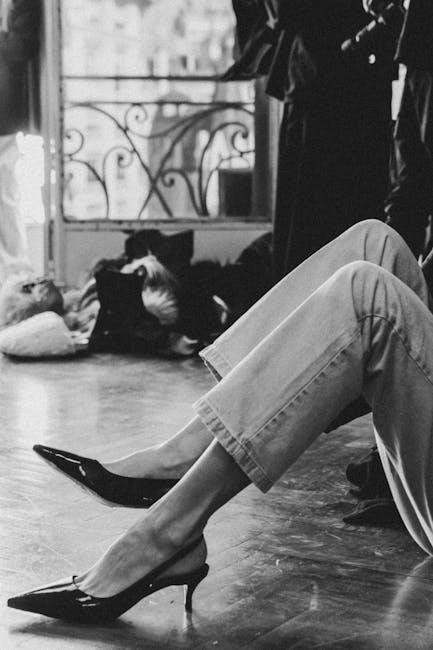C.S. Lewis’s The Lion, the Witch and the Wardrobe is a timeless children’s fantasy novel, first published in 1950, introducing readers to the magical land of Narnia.
1.1 Overview of the Book
The Lion, the Witch and the Wardrobe is a timeless children’s fantasy novel by C.S. Lewis, published in 1950. It introduces readers to the magical land of Narnia, where four siblings—Peter, Susan, Edmund, and Lucy—discover a wardrobe that transports them to an enchanted world ruled by the evil White Witch. The story explores themes of courage, sacrifice, and redemption as the children, aided by the majestic lion Aslan, battle the Witch to restore peace to Narnia. Rich in symbolism and adventure, the book is the first in The Chronicles of Narnia series, captivating readers with its vivid imagery and moral depth.
1.2 The Author: C.S. Lewis
C.S. Lewis, a renowned British author, philosopher, and theologian, crafted The Lion, the Witch and the Wardrobe as part of his celebrated Chronicles of Narnia series. Born in 1898, Lewis was a professor at Oxford and Cambridge universities, blending intellectual rigor with imaginative storytelling. His works often explore themes of faith, morality, and the struggle between good and evil, resonating with readers of all ages. Lewis’s legacy endures through his literary contributions, making The Lion, the Witch and the Wardrobe a beloved classic in children’s literature and beyond.
1.3 Historical Context and Background
The Lion, the Witch and the Wardrobe was written during World War II, a time of global turmoil. C.S. Lewis drew inspiration from the evacuations of children to the countryside, reflecting the era’s uncertainty. The story also resonates with themes of hope and redemption, offering escape through its magical world. Published in 1950, it became the first book in The Chronicles of Narnia series, blending Christian allegory with fantasy. The historical backdrop of war and hardship influenced its narrative, making it a timeless tale of courage and transformation for readers of all ages.

Plot Summary of “The Lion, the Witch and the Wardrobe”
Four siblings discover Narnia through a wardrobe, encountering the evil White Witch, the heroic lion Aslan, and a world frozen in eternal winter, leading to a climactic battle between good and evil;
2.1 The Discovery of Narnia
During World War II, the Pevensie siblings—Peter, Susan, Edmund, and Lucy—are evacuated to the countryside. While exploring the large, old house of Professor Kirke, Lucy stumbles upon a mysterious wardrobe. Curious, she steps inside and finds herself in a snowy forest, entering the enchanted land of Narnia. There, she meets Mr. Tumnus, a friendly faun, who introduces her to the reality of Narnia’s eternal winter under the White Witch’s rule. This discovery marks the beginning of the siblings’ adventures in Narnia, setting the stage for their encounters with Aslan and the battle between good and evil.
2.2 The Battle Between Good and Evil
The White Witch, with her icy grip on Narnia, represents pure evil, casting a spell of eternal winter without Christmas. Aslan, the mighty lion, embodies good, leading the resistance against her tyranny. The Pevensie siblings, drawn into this conflict, become central figures in the battle. Edmund’s betrayal and subsequent redemption highlight the moral stakes, while Aslan’s sacrifice and resurrection symbolize the ultimate triumph of good over evil. The climactic battle showcases courage, loyalty, and the enduring power of righteousness, culminating in the defeat of the White Witch and the restoration of peace to Narnia.
2.3 The Sacrifice and Resurrection of Aslan
Aslan, the symbolic representation of goodness and sacrifice, willingly offers his life to save Edmund, who had betrayed the group to the White Witch. Bound to the Stone Table, Aslan is slain by the Witch, fulfilling the ancient prophecy. However, through the power of the Deep Magic, Aslan is resurrected, returning stronger and more powerful. This act of sacrifice and rebirth not only redeems Edmund but also galvanizes the forces of good in Narnia, leading to the eventual defeat of the White Witch and the restoration of peace to the land.
2.4 The Coronation of the Pevensie Children
Following the defeat of the White Witch, the Pevensie children are crowned as kings and queens of Narnia. Peter, the High King, rules with wisdom, while Susan, Lucy, and Edmund govern their respective territories. This coronation symbolizes their growth into courageous and noble leaders. The event marks the beginning of Narnia’s Golden Age, a period of peace and prosperity under their reign. Aslan’s prophecy is fulfilled, and the children’s bravery is celebrated, solidifying their legacy as heroes of Narnia.

Main Characters in the Story
The Pevensie siblings—Peter, Susan, Edmund, and Lucy—drive the narrative alongside Aslan, the wise lion, and the White Witch, who embodies evil in Narnia.
3.1 The Pevensie Children: Peter, Susan, Edmund, and Lucy
The Pevensie siblings—Peter, Susan, Edmund, and Lucy—are central to the story, each embodying unique traits. Peter, the eldest, initially struggles with leadership but matures into a brave king. Susan, practical and cautious, often acts as the voice of reason, while Lucy, the youngest, is marked by her innocence and faith. Edmund, tempted by the White Witch’s promises, betrays his siblings but later redeems himself through courage and loyalty. Together, they navigate Narnia’s magical world, growing individually and collectively as they confront challenges and ultimate triumph.
3.2 Aslan the Lion and the White Witch
Aslan, the wise and powerful lion, symbolizes goodness and redemption, while the White Witch embodies evil and tyranny. Aslan’s sacrifice and resurrection are pivotal, showcasing his divine nature. The White Witch, with her icy grip on Narnia, represents oppression and fear. Their conflict is a battle between light and darkness, freedom and enslavement. Aslan’s leadership and the Witch’s cruelty drive the story’s moral and emotional core, illustrating the triumph of sacrifice over tyranny and the enduring power of love and forgiveness in the face of evil.
3.3 Supporting Characters: Mr. Tumnus, the Beavers, and Others
Mr. Tumnus, a kind-hearted faun, befriends Lucy and introduces her to Narnia’s magic. The Beavers, wise and loyal, guide the Pevensies, providing crucial information about Aslan and the White Witch. Other supporting characters, like Schrödinger, add depth to the story. These characters play vital roles in the narrative, offering guidance, hope, and assistance to the Pevensies. Their contributions enrich the story, highlighting themes of friendship, trust, and sacrifice. Together, they help shape the journey of the main characters and the fate of Narnia, making the world of Narnia even more vibrant and meaningful.

Themes and Symbolism in the Book
The Lion, the Witch and the Wardrobe explores themes of courage, sacrifice, and redemption, symbolized by Aslan’s journey and the White Witch’s tyranny, reflecting moral struggles.
4.1 Courage and Sacrifice
Courage and sacrifice are central themes in The Lion, the Witch and the Wardrobe. Aslan’s ultimate sacrifice, giving his life to save Edmund, embodies selfless courage and redemption. The Pevensie children also demonstrate bravery: Lucy’s faith in the unseen, Peter’s leadership in battle, and Edmund’s redemption through risking his life to destroy the White Witch’s wand. These acts highlight the moral strength required to confront evil and the transformative power of sacrifice. The story inspires readers to face challenges with courage and understand the profound impact of selfless acts. Aslan’s resurrection further symbolizes the triumph of courage over tyranny.
4.2 Redemption and Forgiveness
Redemption and forgiveness are pivotal themes in The Lion, the Witch and the Wardrobe; Edmund’s betrayal of his siblings and subsequent redemption through bravery in battle showcase personal growth and forgiveness. Aslan’s sacrifice symbolizes divine forgiveness, offering redemption to Edmund and hope to Narnia. The White Witch’s refusal to forgive underscores the destructive nature of unforgiveness. These elements highlight the transformative power of forgiveness and the possibility of redemption, even in the face of great wrongdoing. The story emphasizes that forgiveness is essential for healing and restoring relationships, both among humans and in the divine realm. Aslan’s grace exemplifies this beautifully.
4.3 The Struggle Between Good and Evil
The struggle between good and evil is a central theme in The Lion, the Witch and the Wardrobe. Aslan, the noble lion, embodies goodness, while the White Witch represents tyranny and evil. Their conflict symbolizes the universal battle between light and darkness. The story highlights the triumph of good over evil through Aslan’s resurrection and the defeat of the White Witch. The Pevensie children’s journey reflects moral choices, with Edmund’s betrayal and redemption illustrating the internal struggle between right and wrong. This theme underscores the idea that true victory comes through sacrifice and steadfast commitment to justice and righteousness.

Stage and Screen Adaptations
The Lion, the Witch and the Wardrobe has been adapted into successful stage plays and films, including the 2005 movie, bringing the magical story to life for new audiences.
5.1 The Lion, the Witch and the Wardrobe Stage Play
The stage adaptation of The Lion, the Witch and the Wardrobe has captivated audiences worldwide with its enchanting portrayal of Narnia. Productions like the West End adaptation and tours in Edinburgh’s Festival Theatre bring the story to life through vivid costumes, puppetry, and imaginative sets. Directors such as Ann-Marie Pereth and Chris Klinger have infused the play with music and whimsy, creating a magical experience. The play stays true to C.S. Lewis’s vision, blending themes of courage and redemption. Its success lies in its ability to transport audiences into the heart of Narnia, making it a timeless theatrical delight.
5.2 Film Adaptations and Their Reception
The Lion, the Witch and the Wardrobe has been adapted into several films, with the 2005 version being the most notable. Directed by Andrew Adamson, it grossed over $745 million worldwide, praised for its visual effects and faithfulness to the book. The film captures the magical journey of the Pevensie children, showcasing themes of courage and sacrifice. Audiences and critics lauded the adaptation, with many commending the portrayal of Aslan and the White Witch. The film’s success highlights the enduring appeal of C.S. Lewis’s story, making it a beloved cinematic experience.
- The 2005 film adaptation is a visual masterpiece.
- It stays true to the original story while adding cinematic flair.
- The movie received widespread acclaim for its themes and character development.
The Book’s Impact and Legacy
The Lion, the Witch and the Wardrobe has become a cultural icon, inspiring countless adaptations and influencing fantasy literature. Its timeless themes resonate across generations.
6.1 Cultural Significance and Influence
The Lion, the Witch and the Wardrobe has profoundly shaped popular culture, inspiring films, stage plays, and sparking imaginations worldwide. Its themes of courage, sacrifice, and redemption resonate deeply, making it a beloved classic. The novel’s influence extends beyond literature, impacting art, music, and even theology. Its ability to transcend age boundaries has cemented its place as a cornerstone of fantasy literature, continuing to inspire new adaptations and interpretations. The story remains a timeless tale of hope and transformation, leaving an indelible mark on global culture.
6.2 The Book’s Place in the Chronicles of Narnia Series
The Lion, the Witch and the Wardrobe is the first published and most iconic book in C.S. Lewis’s Chronicles of Narnia series. It serves as an introduction to the magical land of Narnia, its creatures, and central themes of good vs. evil. The story establishes key characters like Aslan and the Pevensie children, setting the foundation for the series. While it is the second book in chronological order, its publication first made it a gateway for readers into Narnia. Its success paved the way for the remaining six books, solidifying its crucial role in the series.
Availability and Downloads
The Lion, the Witch and the Wardrobe PDF is widely available for download, offering readers digital access to this beloved tale in the Chronicles of Narnia series.
7.1 The Lion, the Witch and the Wardrobe PDF Downloads
The Lion, the Witch and the Wardrobe PDF is widely available for download, offering readers a convenient way to access this classic tale digitally. The PDF format ensures the story’s magical illustrations and text are preserved, allowing fans to enjoy C.S. Lewis’s masterpiece on various devices. Many websites provide free or paid downloads, though it’s important to ensure legality and respect copyright. Purchasing official copies supports authors and publishers. This digital version is ideal for those seeking a portable and easily accessible way to experience the enchanting world of Narnia.
7.2 Legal and Ethical Considerations for Digital Copies
Downloading The Lion, the Witch and the Wardrobe PDF requires adherence to copyright laws to ensure ethical access. While free downloads are tempting, they often violate copyright protections, potentially harming authors and publishers. Purchasing official digital copies supports creators and upholds legal standards. Always verify the legitimacy of the source to avoid illegal downloads. Ethical consumption promotes a fair system for writers and publishers, ensuring future literary works continue to thrive. Respect for intellectual property fosters a culture of honesty and appreciation for the creative efforts behind beloved stories like The Lion, the Witch and the Wardrobe.
